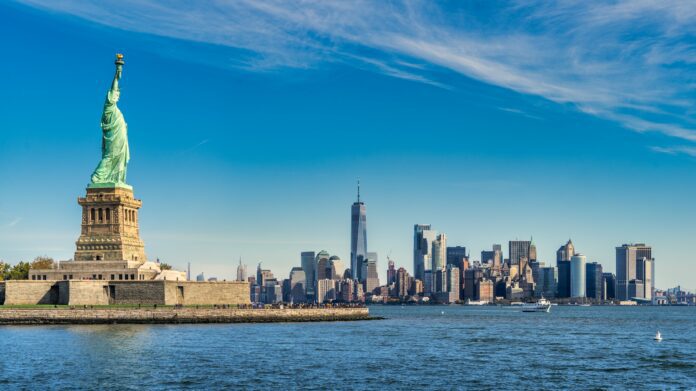Nothing strengthens the bond between two people like cooperating on a gift that celebrates both parties. When entire countries do it, the end results are spectacular. Back in the 1800’s, France and the United States undertook such a project: The Statue of Liberty. Constructed as a symbol of friendship, both countries put in a massive effort to make the statue a reality. With France working on lady liberty and America constructing the pedestal she stands on, both countries got their citizens very involved in the process of creating one of the world’s most recognizable monuments.
In 1865, the Union victory in the Civil War still fresh, the French decided to gift the Reunited States a statue commemorating the friendship the two nations had formed over the decades. The Americans of the time loved the idea, so France began a decade long fundraising campaign. Once the funds were raised, the construction of the statue began under the guidance of Eugène-Emmanuel Viollet-le-Duc and Alexandre-Gustave Eiffel. Yes, the same Eiffel who the tower is named after. This guy couldn’t stop making historical landmarks! Eiffel and Emmanuel tackled this task by hammering flexible copper sheets, which could withstand the winds of New York Harbor, and assembled each piece over four enormous steel supports.
Meanwhile, America needed a place to put this behemoth monument, and a small island near New York City was the perfect spot. Bedloe’s Island held a fort built during the War of 1812. It was decided that Fort Wood would have the pedestal built in its courtyard once all the funds were raised. And boy were they raised. Famous Americans loved the idea of this monument and leapt at the chance to participate. While the money was being collected, design and construction of the base began under the supervision of architect Richard Morris Hunt.
Hunt was the first American to attend the École des Beaux-Arts in Paris, which influenced much of his work in the US. Once he saw the base was to be built in the eleven-point star walls of Fort Wood, he knew he had to make a statement all his own with his pedestal design. Originally, proposal for the pedestal was provided by an architect by the name of Auguste Bartholdi, another major player in the statue’s construction. Bartholdi’s original idea was to add to the existing fortress, towering and sturdy in the middle. This design wasn’t much to look at, so it was initially rejected. Hunt, however, saw potential in the idea and made it more aesthetically pleasing by adding elements of the ancient lighthouse of Alexandrea. This proposal was accepted but scaled down due to budget cuts. Still, the 87-foot pedestal began construction in 1884.
With the pedestal nearly complete in the States, it was time to ship the statue itself over the Atlantic. The Statue was built to be taken apart and put back together for easy assembly once it reached its destination in June 1886. In four months’ time, the statue was reassembled, mounted on Hunt’s pedestal, and a dedication ceremony was held by Grover Cleveland on October 28th, 1886. After two decades of planning, fundraising, and construction, the Statue of Liberty was finally complete. A poem, “The New Colossus” written by Emma Lazarus, can be found at the entrance of the pedestal. Emma won the right to have her poem displayed in a fundraising contest in 1883. Reflecting the spirit of cooperation and freedom the statue represents, “The New Colossus” was the perfect way to mark the completion of this monument.
Since then, the Lady Liberty has gone through a lot of maintenance. The statue itself turned green due to the copper exterior being exposed to decades of air exposure and rainfall. The torch was converted to electric power in 1916 before replaced altogether in the 1980’s. In fact, the entire statue went under a massive restoration and renovation in the 1980’s for the bicentennial. However, since its founding, the most drastic changes have happened to the base of the statue.
The Statue of Liberty was originally under the jurisdiction of the US Lighthouse Board because of the light in the torch. But remember, the pedestal was built in the middle of Fort Wood, which was still an active military base. The military took control of the statue’s maintenance in 1901 until the Fort Wood’s deactivation in 1937. It was then that the entire Island was incorporated into the monument, effectively making it the new base of the statue. This was further illustrated by the island’s name change from Bedloe’s Island to Liberty Island. In 1965, Ellis Island became part of the monument’s jurisdiction meaning the base of The Statue of Liberty is currently around 58 acres.
The former Fort Wood also acted as a museum for the Statue. Once past “The New Colossus” victors could see exhibits ranging from the history of the monument to the original torch from 1886. This part of the monument, sadly, was shut down and replaced with the Statue of Liberty Museum, a building that does not rest beneath a statue of a giant woman. Now a days, the only way to see the pedestal and the Statue interior is to make a reservation.
In 1984 the United Nations listed the Statue of Liberty as a World Heritage Site due to its symbolism for immigrants, refugees, and the idea of international cooperation. Sadly, international cooperation doesn’t seem to be a value many people hold dear anymore. However, that spirit will never be lost completely in the United States. When the Statue was restored in the 1980’s, it was done so with the help of the French, mirroring how the monument came to be in the first place. America provided the sturdy base so others could see Lady Liberty beckon to them in the dark and the cold. The monument provides hope that everyone suffering will be provided with help, care, and safety. We must never forget that The Statue of Liberty was a cooperative process. One that must happen again and again in order to make life better for everyone on Earth.
Russell is a writer and comic based in New York City. His plays have been featured at Penn State’s Cultural Conversation’s Festival, The NYC Thespis Festival, and Imaginarium’s Inaugural Theater Festival. Follow him on TikTok and Instagram @pooleparty528



